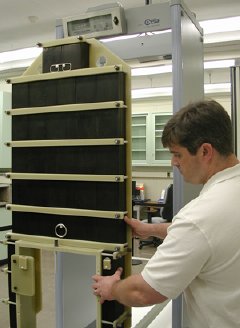Dec 26 2008
In the comics, the Phantom is a masked crimefighter who protected the innocent from pirates, hijackers and other evildoers. While not as dashing or exciting as its costumed namesake, this electromagnetic phantom—a carbon and polymer mixture that simulates the human body—is being readied by the National Institute of Standards and Technology (NIST) for its upcoming role as a different kind of protector. The NIST phantom serves as a mannequin in a standardized performance test for walk-through metal detectors or WTMDs such as those used at airports.
 Guest researcher John Jendzurski prepares the NIST electromagnetic phantom for passage through the walk-through metal detector behind it. The carbon-polymer blocks of the phantom are arranged in a form that simulates the mass and height of the average American adult male. Metal objects such as the mock eyeglasses and belt buckle (top and center of the phantom) test the detector's function.
Guest researcher John Jendzurski prepares the NIST electromagnetic phantom for passage through the walk-through metal detector behind it. The carbon-polymer blocks of the phantom are arranged in a form that simulates the mass and height of the average American adult male. Metal objects such as the mock eyeglasses and belt buckle (top and center of the phantom) test the detector's function.
Metal detectors currently are evaluated by using “clean testers” (human subjects) who walk through the detector adorned with different types of innocuous metal objects, such as eyeglasses, belt buckles, watches, jewelry and coins, or by a piece of plywood pushed through the metal detector with the same items mounted on it. The disadvantage of using human subjects is that person-to-person variability in physical makeup and walking style and changes in a particular person’s gait or position at each pass makes standardization impossible. The second method is reproducible, but it can’t tell evaluators how a human body may impact the WTMD’s ability to discriminate between weapons and innocuous objects.
The solution for both problems came from the lab. With funding from the U.S. Department of Justice’s National Institute of Justice (NIJ), researchers in NIST’s Electromagnetics Division mixed a polymer with carbon black—a fine powder made almost entirely of elemental carbon—to yield a low-cost, easily molded compound that can mimic the average electrical conductivity of the human body (which includes blood, bone, fat, organs, muscle and skin). The material is shaped into brick-like blocks and then arranged on a non-conductive fiberglass frame in a form that simulates the mass and height of the average American adult male.
Once assembled, the NIST phantom is placed atop a low-friction nonmetallic cart and passed through a WTMD at a speed of 0.5 meters per second by a computer-controlled actuator. This speed was selected because it is a common walking pace for an adult male. Engineers in NIST’s Office of Law Enforcement Standards used the data from recent trials to design and support a reproducible process incorporating the phantom that will evaluate a walk-through metal detector’s ability to discriminate between threatening and non-threatening objects, such as the simulated eyeglasses or belt buckle. Plans call for the testing protocol to be considered in a future revision of the NIJ standard on metal detector performance.